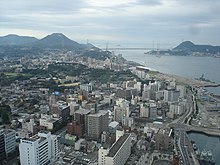Yamaguchi Prefecture
He was forced to give up all his land except for the Suō and Nagato areas (current-day Yamaguchi Prefecture), where he built his castle in Hagi.Mōri sought to strengthen the economic base of the region and increase local production with his Three Whites campaign (salt, rice, and paper).After Commodore Matthew Perry's opening of Japan, clans from Nagato (also called Chōshū) played a key role in the fall of the Tokugawa shogunate and the establishment of the new imperial government.In the Taishō period, from 1912 to 1926, shipbuilding, chemical, machinery, and metal working plants were built in Yamaguchi's harbors in the Seto Inland Sea area.During the post-World War II Shōwa Period, Yamaguchi developed into one of the most industrialized prefectures in the country due to the establishment of petrochemical complexes.The area on the banks of the Nishiki river close to the bridge is considered among the best places in Japan for Hanami, when groups of family and friends gather in early April to view cherry blossoms.[14][15] Since the Meiji Restoration in which lower-rank nobility from Chōshū played a major role, many politicians from Yamaguchi have held important positions in national politics.He won the gubernatorial election in February 2014 with more than 60% of the vote against other two candidates, and succeeded Shigetarō Yamamoto who had been hospitalized since October 2013 and resigned in January 2014.





Yamaguchi (city)Yamaguchi, NaganoYamanashi PrefectureYamagata PrefecturePrefectureJapaneseRōmajiIwakuniIwakuni CastleNishiki RiverRegionChūgokuIslandHonshuCapitalYamaguchiShimonosekiDistrictsMunicipalitiesGovernorTsugumasa MuraokaISO 3166 codeHooded craneJapanese pufferBitter summer mandarin blossomRed pine treeChūgoku regionShimane PrefectureHiroshima PrefectureShūnanSea of JapanSeto Inland SeaKyushuKanmon StraitsList of Historic Sites of Japan (Yamaguchi)NagatosamuraiKamakuraMuromachi periodMing DynastySue HarutakaMōri MotonariMōri clanSengoku periodMōri TerumotoTokugawa IeyasuSekigaharaMatthew Perryopening of JapanChōshūTokugawa shogunateEdo ShogunateMeiji governmentTaishō periodShōwa PeriodSetonaikai National ParkAkiyoshidaiKita-Nagato KaiganNishi-Chūgoku SanchiChōmonkyōIwakiyamaRakanzanToyotaList of cities in Yamaguchi Prefecture by populationHikariKudamatsuSan'yō-OnodaKaminosekiSuō-ŌshimaTabuseList of mergers in Yamaguchi PrefectureNorthern KyushuKaratoKintai BridgeHanamiHagi CityTakasugi Shinsakureverberatory furnaceSeinan RebellionAkiyoshidai Quasi-National ParkBaiko Gakuin UniversityShimonoseki City UniversityTokyo University of Science, YamaguchiUbe Frontier UniversityUniversity of East AsiaYamaguchi Gakugei CollegeYamaguchi Prefectural UniversityYamaguchi UniversityYamaguchi University of Human Welfare and CultureQingdaoShanghaiGwangyangKunisakiMatsuyamaShikokuIwakuni Kintaikyo AirportNaha AirportOkinawaYamaguchi Ube AirportHaneda AirportWest Japan Railway CompanyGantoku LineOnoda LineMine LineSanin LineSanyō ShinkansenSan'yō Main LineUbe LineYamaguchi LineChūgoku ExpresswaySanyo ExpresswayKanmon BridgeRoute 2Route 9Route 187TsuwanoMasudaRoute 188Route 189Route 190Route 191Route 262Route 315Route 316Route 376Route 434